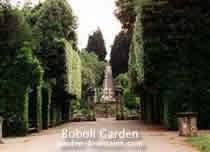 Ammannati's Influence Continues
Ammannati's Influence Continues
The walls of the common garden grounds were complete with columns and statuary. We know this from the writings of Vasari. In a letter by Tanai de' Medici, during the time period when Ammannati was very ill and could not visit Duke Francesco to discuss the figurines, we learned that there were six statues, created out of marble. Two were intended to be placed within niches to flank each side of the entrance. One was to be a girl with flowers within her dress, holding arrows. This statue is not located in the Boboli Garden. The second statue was to be a male statue of Prudence. He was to have an anchor along with a dolphin and is now located within the courtyard of the Bargello. Under the arch, located in the center, the river God Arno is featured, reclining along with a female statue that is intended to be Hippocrene. This, along with the wall fountain of the Muses is also now located in the Boboli Garden. Between the two of them, a statue of a figure or Ceres is featured holding her breast. This statue has now been moved to Bargello.
 Outdoor wall fountains rested above the arch of the garden. These fountains are now lost but featured a depiction of Juno with peacock at her side. The allegory of the fountains that featured Juno and Ceres remind us of the Labyrinth at Castello as well as more modern murals that were created in the Sala degli Elemen located in the Palazzo Vecchio. The well known pieces from the Arno are the traditional wall fountains that are similar to the elements of the Hippocrene. The located of the birdbath between the legs of the statue is reminiscent of Tribolo's pior rivergod birdbath that was located at the Villa Corsini at Castello.
Outdoor wall fountains rested above the arch of the garden. These fountains are now lost but featured a depiction of Juno with peacock at her side. The allegory of the fountains that featured Juno and Ceres remind us of the Labyrinth at Castello as well as more modern murals that were created in the Sala degli Elemen located in the Palazzo Vecchio. The well known pieces from the Arno are the traditional wall fountains that are similar to the elements of the Hippocrene. The located of the birdbath between the legs of the statue is reminiscent of Tribolo's pior rivergod birdbath that was located at the Villa Corsini at Castello.
Reconstruction of these elaborate niche fountains has not been done. The rainbow that contained the river gods and the figure of Ceres were located in a classical facade. A part of the arch is still attached to the statues of the river god, but is most definitely a complete circle. It is thought that it may have belong to a lyre-shaped figure that had resembled the bronze knockers that featured statues in the center. These statues are very common within the collections of Venetian bronzes and wall fountains of the time period. Today, these can be seen in the collection of the Schlossmuseum in Berlin.
The treatment of the water within the fountain lead the nose arches of the dolphin, as well as the breasts of the Ceres to have holes from the creation of room for the popes. Lucky, the urns with the river gods were not altered even though it is thought Ammannati had planned to do so. Many have wondered about these statues, but that is as far as it has gone because no one knows for sure about the wall fountains that flanked these statues.
